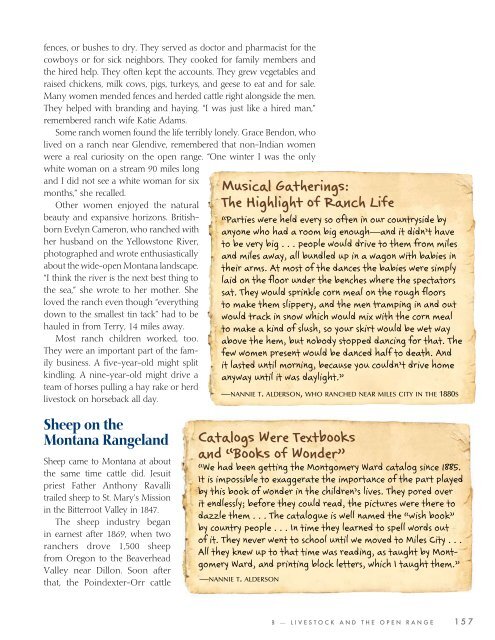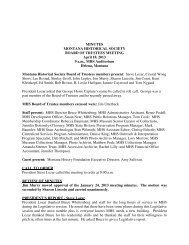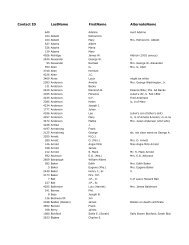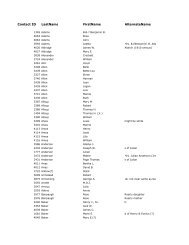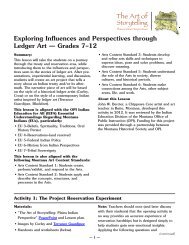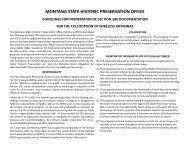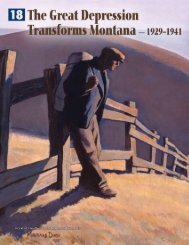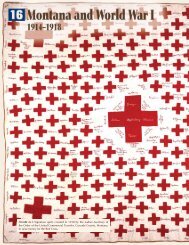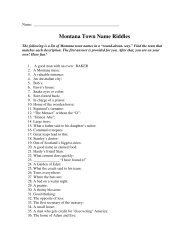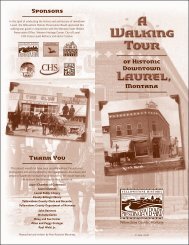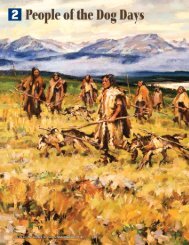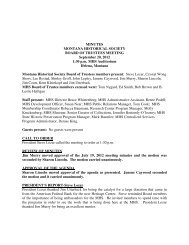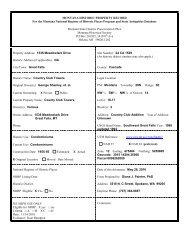148 1830s 1850 1840 1845 1855 1860 - Montana Historical Society
148 1830s 1850 1840 1845 1855 1860 - Montana Historical Society
148 1830s 1850 1840 1845 1855 1860 - Montana Historical Society
You also want an ePaper? Increase the reach of your titles
YUMPU automatically turns print PDFs into web optimized ePapers that Google loves.
fences, or bushes to dry. They served as doctor and pharmacist for the<br />
cowboys or for sick neighbors. They cooked for family members and<br />
the hired help. They often kept the accounts. They grew vegetables and<br />
raised chickens, milk cows, pigs, turkeys, and geese to eat and for sale.<br />
Many women mended fences and herded cattle right alongside the men.<br />
They helped with branding and haying. “I was just like a hired man,”<br />
remembered ranch wife Katie Adams.<br />
Some ranch women found the life terribly lonely. Grace Bendon, who<br />
lived on a ranch near Glendive, remembered that non-Indian women<br />
were a real curiosity on the open range. “One winter I was the only<br />
white woman on a stream 90 miles long<br />
and I did not see a white woman for six<br />
months,” she recalled.<br />
Other women enjoyed the natural<br />
beauty and expansive horizons. Britishborn<br />
Evelyn Cameron, who ranched with<br />
her husband on the Yellowstone River,<br />
photographed and wrote enthusiastically<br />
about the wide-open <strong>Montana</strong> landscape.<br />
“I think the river is the next best thing to<br />
the sea,” she wrote to her mother. She<br />
loved the ranch even though “everything<br />
down to the smallest tin tack” had to be<br />
hauled in from Terry, 14 miles away.<br />
Most ranch children worked, too.<br />
They were an important part of the family<br />
business. A fi ve-year-old might split<br />
kindling. A nine-year-old might drive a<br />
team of horses pulling a hay rake or herd<br />
livestock on horseback all day.<br />
Sheep on the<br />
<strong>Montana</strong> Rangeland<br />
Sheep came to <strong>Montana</strong> at about<br />
the same time cattle did. Jesuit<br />
priest Father Anthony Ravalli<br />
trailed sheep to St. Mary’s Mission<br />
in the Bitterroot Valley in 1847.<br />
The sheep industry began<br />
in earnest after 1869, when two<br />
ranchers drove 1,500 sheep<br />
from Oregon to the Beaverhead<br />
Valley near Dillon. Soon after<br />
that, the Poindexter-Orr cattle<br />
Musical Gatherings:<br />
The Highlight of Ranch Life<br />
“Parties were held every so often in our countryside by<br />
anyone who had a room big enough—and it didn’t have<br />
to be very big . . . people would drive to them from miles<br />
and miles away, all bundled up in a wagon with babies in<br />
their arms. At most of the dances the babies were simply<br />
laid on the floor under the benches where the spectators<br />
sat. They would sprinkle corn meal on the rough floors<br />
to make them slippery, and the men tramping in and out<br />
would track in snow which would mix with the corn meal<br />
to make a kind of slush, so your skirt would be wet way<br />
above the hem, but nobody stopped dancing for that. The<br />
few women present would be danced half to death. And<br />
it lasted until morning, because you couldn’t drive home<br />
anyway until it was daylight.”<br />
—NANNIE T. ALDERSON, WHO RANCHED NEAR MILES CITY IN THE 1880S<br />
Catalogs Were Textbooks<br />
and “Books of Wonder”<br />
“We had been getting the Montgomery Ward catalog since 1885.<br />
It is impossible to exaggerate the importance of the part played<br />
by this book of wonder in the children’s lives. They pored over<br />
it endlessly; before they could read, the pictures were there to<br />
dazzle them . . . The catalogue is well named the “wish book”<br />
by country people . . . In time they learned to spell words out<br />
of it. They never went to school until we moved to Miles City . . .<br />
All they knew up to that time was reading, as taught by Montgomery<br />
Ward, and printing block letters, which I taught them.”<br />
—NANNIE T. ALDERSON<br />
8 — L I V E S T O C K A N D T H E O P E N R A N G E 1 5 7


